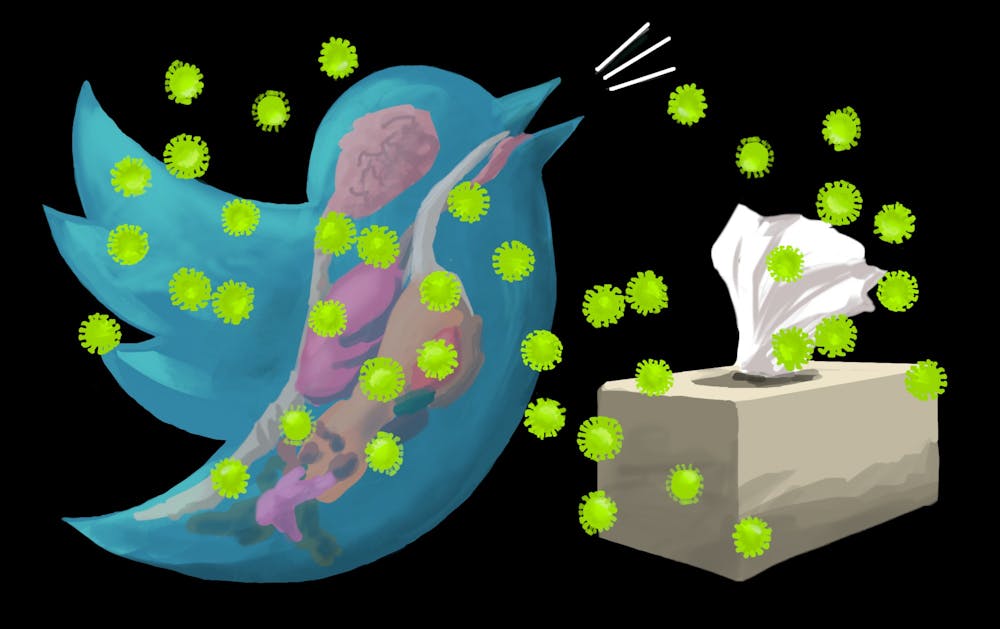ASU faculty and students at the New College of Interdisciplinary Arts and Sciences have developed a new flu surveillance system using Twitter.
The team uses algorithms and analysis of geotagged data on Twitter alongside mathematical equations to create daily real-time results on flu detection throughout the U.S. The project is funded by the National Science Foundation.
“We want to understand the flu signals in Twitter and how we can utilize them to help us understand the flu spreading in real life,” said Feng Wang, a faculty member for the team and an associate professor at the School of Mathematical and Natural Sciences at the New College of Interdisciplinary Arts and Sciences.
So far, the team has been able to create comparable results with the weekly Center for Disease Control and Prevention count on the flu with only a few anomalies in their data, which they are currently refining, Wang said.
A major benefit of their Twitter tracker compared to the CDC’s is that the team is able to publish daily flu results, whereas the CDC can take anywhere between one to two weeks to release their information.
They are continually working on their predicting server, which according to Wang is running at close to 85% accuracy as of now. This work though is not on the website yet as they are still developing a way to visualize the data.
After years of developing their system and refining their algorithms, they have officially launched their own Twitter account along with updating their website to help share their findings and information to better help health professionals and increase their visibility.
According to Wang, the team started this research in 2014 and has had generations of students throughout the years involved with the development of their work. She added further that the New College promotes undergraduate students to get involved with research through their New College Undergraduate Inquiry & Research Experiences, more commonly referred to as NCUIRE.
“It connects students with faculty to do research,” James Sulikowski, the associate director at the School of Mathematical and Natural Sciences, said. “You connect with a professor, you come up with a project, you outline it, and move it forward by learning different research skills.”
The program has allowed the faculty to connect with undergraduate students looking to gain more practical real-world experience in research and coding.
One example is senior Andrew Lamontagne, who is majoring in applied computing and is in his third semester with the team and leads a group of five students working on the project, Wang said.
The project at its very core is simply using Twitter's Advanced Search, but with the algorithms they have developed, they’ve been able to refine their system.
Wang added one of the big parts of this is their SVM or Support Vector Machine module, which automatically excludes certain results and find the right tweets that identify users who actually are experiencing flu symptoms.
“When the flu season starts we have very low correlation, there is a lot of noise,” Lamontagne said. “So we're just looking to train the SVM with more training tweets … some of those tweets may actually be very useful.
"Like what is a tweet's reply? Should you classify it as a flu tweet or a flu awareness tweets, right? Someone retweets someone? Should that be classified as their own words or not?”
Continuing to refine the algorithms will yield more accurate results, and according to Wang it would ideally be able to give reliable information on outbreaks going forward.
Wang added that she is originally from Wuhan, a city in China where the recent outbreak of a Coronavirus started, noting that if something similar happened in the U.S., CDC information may be too late as it is weeks behind, whereas her teams research is updated every day.
“If we actually have a tool like this which really works accurately it can give a strong signal to the government and tell them they should take action much earlier before it is too late.” Wang said.
Reach the reporter at wmyskow@asu.edu and follow @wmyskow on Twitter.
Like The State Press on Facebook and follow @statepress on Twitter.

Wyatt Myskow is the project manager at The State Press, where he oversees enterprise stories for the publication. He also works at The Arizona Republic, where he covers the cities of Peoria and Surprise.




